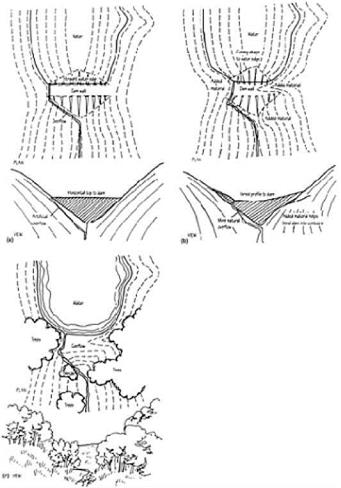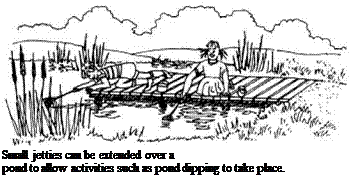As well as bringing people to the wildlife it is possible to bring wildlife to the people. Areas can be developed into open glades, wetlands or ponds that attract deer, birds, butterflies and other wildlife. Such areas should be designed not just to provide good habitat but also to look as natural as possible.
 |
Open glades in a forest, where sunny edge habitat, good quality forage, water and mineral licks are provided, can attract shy creatures such as deer regularly enough so that visitors have a high probability of seeing them. The edge design of such glades, their shape, size and the impact of management activities should be carefully considered. Irregularly shaped areas where the open space tends to be in the hollows among landform will often look more natural. For similar effects, groups of shrubs planted for browsing should be placed at irregular intervals and be of varied sizes, while trees pruned to let more light into the edge or to open up the edge for a view should have the height of the
pruning level varied.
Glades in woodland can also be developed for butterflies and insects, which do not usually move away from humans like animals or birds do. Vegetation management is the key here. Edges of trees, patches of shrubs of different varieties and heights, herbaceous vegetation and grassy areas maintained on a cycle of cutting and mowing will provide the food plants of indigenous species for butterfly larvae and the nectar-giving flowers for the adults to feed on. The design of these glades can be developed by varying their width, the shape of the space and their direction to create wonderful linear habitats as part of a trail through the landscape.
Wetlands and ponds should be made to look natural with varying water levels, curvilinear shapes and graded edges to allow different vegetation types to be developed in different places. Irregularly shaped islands placed off centre in ponds will help to protect waterfowl from vermin. Bays and promontories will increase the territories available for different birds and add to the natural effect.
If dams are constructed to convert a stream into a wildlife pond these should be designed to blend into the surrounding landform as well as possible. Engineered, trapezoidal retaining walls stand out artificially in the scene, and should be modified with naturally shaped earth mounds and plenty of shrubs and trees.
Old gravel workings often make excellent habitats for a wide range of wildlife in areas close to cities, where excavation can leave well shaped areas that colonize quickly. Wildlife observation can go hand in hand with environmental education in these circumstances, particularly when schools are close
by.
As well as the more obvious larger animals, birds and fish, viewing opportunities are possible for other wildlife. In wet areas small jetties can be erected from which pond dipping can take place. This allows children as part of education or play (see Chapter 8)
 |
The design of dam walls for wildlife
ponds needs care: (a) A basic dam wall with a symmetrical profile and flat top. (b) Earth has been added to the dam to vary its profile and to blend it into the nearby contours. (c) Vegetation on the parts with extra soil helps to blend it further into the surroundings, so long as the roots are prevented from damaging the clay core of the dam.
 |
to see frogs, snails, newts, water beetles and small fish, which are just as useful and fascinating to study. Shallow places can be used for wading with nets for the same purposes.
![]()
Chapter Twelve
Design for overnight
visitors
Previous chapters have concentrated on designing for visitors who go to an area primarily for a day trip and leave before the evening.
However, the outdoors can be particularly attractive at other times of day, especially at dawn and dusk. There is also something special about staying longer at a place, when there is time to know it better, to explore remote places and absorb the atmosphere. Nights spent in wild places, whether unrolling a sleeping bag beneath the stars, camping in a tent, a trailer caravan, a motor home or staying in a cabin can complete the sense of closeness to nature, extend the period of unwinding and relaxation, and permit more extended routes on foot, horseback, allterrain cycle, skis, boat or kayak to be explored. Some of the facilities needed for overnight stops— fireplaces, toilet blocks, horse corrals and shelters— were to some extent covered in the previous chapters. In this chapter the specific requirements of a night’s stay in the outdoors will be discussed. Tents, touring caravans or camper vans/recreational vehicles and cabins will be covered. Static caravans could also be considered in a similar way to cabins in terms of the design considerations for their layout.



